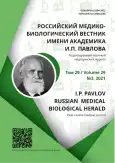Experience of using intra-aortic balloon counterpulsation during coronary bypass surgery and coronary stenting in patients with reduced left ventricular ejection fraction and mitral regurgitation of ischemic genesis
- Authors: Kostyamin Y.D.1, Mikhailichenko V.Y.2, Basiyan-Kuhto N.K.1, Grekov I.S.1
-
Affiliations:
- State educational institution “Donetsk national medical University. M. Gorky”
- Medical Academy named after S.I. Georgievsky of Vernadsky CFU
- Issue: Vol 29, No 3 (2021)
- Pages: 419-426
- Section: Original study
- URL: https://journals.rcsi.science/pavlovj/article/view/60221
- DOI: https://doi.org/10.17816/PAVLOVJ60221
- ID: 60221
Cite item
Abstract
AIM: To analyze the changes in the degree of mitral regurgitation (MR) of ischemic origin and of clinical outcomes in patients with reduced left ventricular ejection fraction (LVEF) and multi-vascular coronary artery disease during use of intra-aortic balloon counterpulsation (IABC).
MATERIALS AND METHODS: The results of the treatment of 186 patients with ischemic mitral insufficiency who underwent intra-aortic balloon counterpulsation as a preoperative preparation in connection with a low LVEF were outlined in this manuscript. The patients were divided into 2 groups. Group 1 included 132 patients who underwent coronary bypass surgery while Group 2 included 54 patients who underwent coronary artery stenting. The dynamics of MR and LVEF before and after left ventricular revascularization were studied on the basis of echocardiographic data.
RESULTS: In group 1, there was a decrease in the degree of mitral regurgitation by 58% using IABC (p < 0.05) in the early postoperative period (based on the measurement of vena contracta, v.c., the width of the regurgitation jet on the valve), and by 54% (p < 0.05) in more than 6 months following surgical treatment. In group 2, there was a significant decrease in the degree of MR (based on v.c.) by 42% (p < 0.05) in the early postoperative period and by 41% (p < 0.05) in more than 6 months following surgical treatment.
CONCLUSION: The use of intra-aortic balloon counterpulsation in patients with low LVEF, moderate and severe MI, and with significant coronary artery pathology, led to the reduction in the duration of surgical treatment and the time of using artificial blood circulation through by excluding the need for the correction of MI, both directly during surgical revascularization and in the long-term period (more than 6 months).
Full Text
##article.viewOnOriginalSite##About the authors
Yuri D. Kostyamin
State educational institution “Donetsk national medical University. M. Gorky”
Email: kostiamin@mail.ru
ORCID iD: 0000-0003-0141-8719
SPIN-code: 8687-0660
MD, Cand. Sci. (Med.)
Ukraine, DonetskVyacheslav Y. Mikhailichenko
Medical Academy named after S.I. Georgievsky of Vernadsky CFU
Email: pancreas1978@mail.ru
ORCID iD: 0000-0003-4204-5912
SPIN-code: 4606-8664
MD, Dr. Sci. (Med.), Professor
Russian Federation, SimferopolNaira K. Basiyan-Kuhto
State educational institution “Donetsk national medical University. M. Gorky”
Email: naira-251088@mail.ru
ORCID iD: 0000-0002-3554-4505
MD, Cand. Sci. (Med.)
Ukraine, DonetskIlya S. Grekov
State educational institution “Donetsk national medical University. M. Gorky”
Author for correspondence.
Email: ilya.grekov.1998@gmail.com
ORCID iD: 0000-0002-6140-5760
6th year student
Ukraine, DonetskReferences
- Baumgartner H, Falk V, Bax JJ, et al. 2017 ESC/EACTS Guidelines for the management of valvular heart disease. European Heart Journal. 2017;38(36):2739–91. doi: 10.1093/eurheartj/ehx391
- Kron IL, Acker MA, Adams DH, et al. 2015 The American Association for Thoracic Surgery Consensus Guidelines: Ischemic mitral valve regurgitation. The Journal of Thoracic and Cardiovascular Surgery. 2016;151(4):940–56. doi: 10.1016/j.jtcvs.2015.08.127
- Roffi M, Patrono C, Collet J-P, et al. 2015 ESC Guidelines for the management of acute coronary syndromes in patients presenting without persistent ST-segment elevation: Task Force for the Management of Acute Coronary Syndromes in Patients Presenting without Persistent ST-Segment Elevation of the European Society of Cardiology (ESC). European Heart Journal. 2016;37(3):267–315. doi: 10.1093/eurheartj/ehv320
- Bokeriya LA, Gudkova RG. Serdechno-sosudistaya khirurgiya — 2015. Bolezni i vrozhdennyye anomalii sistemy krovoobrashcheniya. Moscow: NTsSSKh im. A.N. Bakuleva RAMN; 2016. (In Russ).
- De Bruyne B, Pijls NH, Kalesan B, et al. Fractional flow reserve-guided PCI versus medical therapy in stable coronary disease. The New England Journal of Medicine. 2012;367(11):991–1001. doi: 10.1056/NEJMoa1205361
- Khubulava GG, Marchenko SP, Aleksanyan MG, et al. Mitral valve repair with coronary artery bypass grafting in patients with ischemic mitral regurgitation. Bulletin of the Russian Military Medical Academy. 2013;(1):6–10. (In Russ.).
- Bokeriya LA, Skopin II, Mironenko VA. Ishemicheskaya mitral’naya regurgitatsiya. Sovremennyye podkhody k khirurgicheskomu lecheniyu. Russian Journal of Surgery. 2002;(2):14–21. (In Russ).
- Bursi F, Enriquez-Sarano M, Jacobsen SJ, et al. Mitral regurgitation after myocardial infarction: a review. The American Journal of Medicine. 2006;119(2):103–12. doi: 10.1016/j.amjmed.2005.08.025
- Borger MA, Alam A, Murphy PM, et al. Chronic ischemic mitral regurgitation: repair, replace or rethink? The Annals of Thoracic Surgery. 2006;81(3):1153–61. doi: 10.1016/j.athoracsur.2005.08.080
- Szeto WY, Gorman RC, Gorman JH 3rd, et al. Ischemic mitral regurgitation. In: Cohn L.C. Cardiac Surgery in the Adult. 3rd ed. New York: McGraw-Hill; 2003. P. 785–802.
- Deppe А–C, Weber С, Liakopoulos ОJ, et al. Preoperative intra-aortic balloon pump use in high-risk patients prior to coronary artery bypass graft surgery decreases the risk for morbidity and mortality – A meta-analysis of 9,212 patients. Journal of Cardiac Surgery. 2017;32(3):177–85. doi: 10.1111/jocs.13114
- Poirier Y, Voisine P, Plourde G, et al. Efficacy and safety of preoperative intra-aortic balloon pump use in patients undergoing cardiac surgery: a systematic review and metaanalysis. International Journal of Cardiology. 2016;207:67–79. doi: 10.1016/j.ijcard.2016.01.045
Supplementary files








